| Chief Justice of Republic of the Philippines | |
|---|---|
| Punong Mahistrado ng Pilipinas | |
 Seal of the Supreme Court Seal of the Supreme Court | |
 Flag of the Supreme Court Flag of the Supreme Court | |
 Incumbent IncumbentAlexander Gesmundo since April 5, 2021 | |
| Style | The Honorable (formal) Your Honor (when addressed directly in court) |
| Member of | |
| Appointer | Presidential appointment upon nomination by the Judicial and Bar Council |
| Term length | Retirement at the age of 70 |
| Inaugural holder |
|
| Formation | June 11, 1901 |
| Website | Official Website |
The chief justice of the Philippines (Filipino: Punong Mahistrado ng Pilipinas) presides over the Supreme Court and is the highest judicial officer of the government of the Philippines. As of April 5, 2021, the position is currently held by Alexander Gesmundo, who was appointed by President Rodrigo Duterte following the early retirement of his predecessor, Diosdado Peralta, in March 2021.
The chief justice, who was first named on June 11, 1901, in the person of Cayetano Arellano, is the oldest existing major governmental office continually held by a Filipino, preceding the presidency and vice presidency (1935), senators (1916, or as the Taft Commission, on September 1, 1901) and the members of the House of Representatives (1907 as the Philippine Assembly).
Duties and powers
The power to appoint the chief justice lies with the president of the Philippines, who makes the selection from a list of three nominees prepared by the Judicial and Bar Council. There is no material difference in the process of selecting a chief justice from that in the selection of associate justices. As with the other justices of the Supreme Court, the chief justice is obliged to retire upon reaching the age of 70; otherwise there is no term limit for the chief justice. In the 1935 constitution, any person appointed by the president has to be confirmed by the Commission on Appointments; in the 1973 constitution, the person whom the president appointed did not have to undergo confirmation under the Commission on Appointments.
The current 1987 constitution does not ascribe any formal role to the chief justice other than as an ex-officio chairman of the Judicial and Bar Council and as the presiding officer in any impeachment trial of the president. The chief justice is also required to personally certify every decision that is rendered by the court. The chief justice carries only 1 vote out of 15 in the court, and is generally regarded, vis-a-vis the other justices, as the primus inter pares rather than as the administrative superior of the other members of the court.
Still, the influence a chief justice may bear within the court and judiciary, and on the national government cannot be underestimated. In the public eye, any particular Supreme Court is widely identified with the identity of the incumbent chief justice, hence appellations such as "The Fernando Court" or "The Puno Court". Moreover, the chief justice usually retains high public visibility, unlike the associate justices, who tend to labor in relative anonymity, with exceptions such as Associate Justice J. B. L. Reyes in the 1950s to 1970s.
By tradition, it is also the chief justice who swears into office the president of the Philippines. One notable deviation from that tradition came in 1986, and later again in 2010. Due to the exceptional political circumstances culminating in the People Power Revolution, on February 25, 1986, Corazon Aquino took her oath of office as president before Associate Justice Claudio Teehankee in San Juan just minutes before Ferdinand Marcos took his own oath of office also as president before Chief Justice Ramon Aquino. Marcos fled into exile later that night. More than two decades afterwards, Benigno Simeon Aquino III followed in his mother's footsteps (with almost similar reasons) by having Associate Justice Conchita Carpio-Morales administer his oath of office, rather than Chief Justice Renato Corona (who was eventually impeached halfway through Aquino's term). Six years later, in 2016, Rodrigo Duterte took his oath of office before Associate Justice Bienvenido Reyes, his classmate at San Beda College of Law, instead of Chief Justice Maria Lourdes Sereno (who would eventually be removed from her position through quo warranto after it was determined that she had been unlawfully holding office ab initio).
The chief justice also names the three justices each from the Supreme Court in the memberships of the House of Representatives Electoral Tribunal and the Senate Electoral Tribunal.
The chief justice is the chief executive officer of the Philippine judiciary system and together with the whole Supreme Court, exercises administrative supervision over all courts and personnel.
List
See also: Justices of the Supreme Court of the Philippines and Associate Justice of the Supreme Court of the Philippines| No. | Image | Chief justice | Tenure | Appointed by | Law school | Prior office |
|---|---|---|---|---|---|---|
| 1 | 
|
Cayetano Arellano (1847–1920) |
June 15, 1901 – April 12, 1920 (18 years, 302 days) (Resigned) |
William McKinley | UST | President of the Supreme Court (1899–1901) |
| 2 | 
|
Victorino Mapa (1855–1927) |
July 1, 1920 – October 31, 1921 (1 year, 122 days) (Resigned) |
Woodrow Wilson | Secretary of Justice (1913–1920) Associate Justice of the Supreme Court (1901–1913) | |
| 3 | 
|
Manuel Araullo (1853–1924) |
November 1, 1921 – July 26, 1924 (2 years, 268 days) (Died) |
Warren G. Harding | Associate Justice of the Supreme Court (1913–1921) | |
| 4 | 
|
Ramon Avanceña (1872–1957) |
April 1, 1925 – December 5, 1941 (16 years, 267 days) (Resigned) |
Calvin Coolidge | Associate Justice of the Supreme Court (1917–1925) | |
| 5 | 
|
Jose Abad Santos (1886–1942) |
December 24, 1941 – May 1, 1942 (128 days) (Died) |
Manuel L. Quezon | Northwestern | Associate Justice of the Supreme Court (1932–1941) |
| 6 | 
|
Jose Yulo (1894–1976) |
January 26, 1942 – July 9, 1945 (3 years, 63 days) (Resigned) |
Masaharu Homma | UP | Speaker of the National Assembly (1939–1941) |
| 7 | 
|
Manuel Moran (1893–1961) |
July 9, 1945 – March 20, 1951 (5 years, 254 days) (Resigned) |
Sergio Osmeña | Escuela de Derecho | Associate Justice of the Supreme Court (1938–1945) |
| 8 | 
|
Ricardo Paras (1891–1984) |
April 2, 1951 – February 17, 1961 (9 years, 321 days) (Retired) |
Elpidio Quirino | UP | Associate Justice of the Supreme Court (1941–1951) |
| 9 | 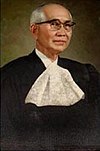
|
Cesar Bengzon (1896–1992) |
April 28, 1961 – May 29, 1966 (5 years, 31 days) (Retired) |
Carlos P. Garcia | Associate Justice of the Supreme Court (1945–1961) | |
| 10 | 
|
Roberto Concepcion (1903–1987) |
June 17, 1966 – April 18, 1973 (6 years, 305 days) (Retired) |
Ferdinand Marcos | UST | Associate Justice of the Supreme Court (1954–1966) |
| 11 | 
|
Querube Makalintal (1910–2002) |
October 21, 1973 – December 22, 1975 (2 years, 62 days) (Retired) |
UP | Associate Justice of the Supreme Court (1962–1973) | |
| 12 | 
|
Fred Ruiz Castro (1914–1979) |
January 5, 1976 – April 19, 1979 (3 years, 104 days) (Died) |
Associate Justice of the Supreme Court (1966–1976) | ||
| 13 | 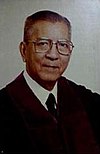
|
Enrique Fernando (1915–2004) |
July 2, 1979 – July 24, 1985 (6 years, 22 days) (Retired) |
Associate Justice of the Supreme Court (1967–1979) | ||
| 14 | 
|
Felix Makasiar (1915–1992) |
July 25, 1985 – November 19, 1985 (117 days) (Retired) |
Associate Justice of the Supreme Court (1970–1985) | ||
| 15 | 
|
Ramon Aquino (1917–1993) |
November 20, 1985 – March 6, 1987 (1 year, 106 days) (Resigned) |
Associate Justice of the Supreme Court (1973–1985) | ||
| 16 | 
|
Claudio Teehankee (1918–1989) |
April 2, 1987 – April 18, 1988 (1 year, 16 days) (Retired) |
Corazon Aquino | Ateneo | Associate Justice of the Supreme Court (1969–1987) |
| 17 | 
|
Pedro Yap (1918–2003) |
April 19, 1988 – June 30, 1988 (72 days) (Retired) |
UP | Associate Justice of the Supreme Court (1986–1988) | |
| 18 | 
|
Marcelo Fernan (1927–1999) |
July 1, 1988 – December 6, 1991 (3 years, 158 days) (Resigned) |
Associate Justice of the Supreme Court (1986–1988) | ||
| 19 | 
|
Andres Narvasa (1928–2013) |
December 8, 1991 – November 30, 1998 (6 years, 357 days) (Retired) |
UST | Associate Justice of the Supreme Court (1986–1991) | |
| 20 | 
|
Hilario Davide Jr. (born 1935) |
November 30, 1998 – December 20, 2005 (7 years, 20 days) (Retired) |
Joseph Estrada | UP | Associate Justice of the Supreme Court (1991–1998) |
| 21 | 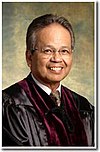
|
Artemio Panganiban (born 1937) |
December 20, 2005 – December 7, 2007 (1 year, 352 days) (Retired) |
Gloria Macapagal Arroyo | FEU | Associate Justice of the Supreme Court (1995–2005) |
| 22 | 
|
Reynato Puno (born 1940) |
December 7, 2007 – May 17, 2010 (2 years, 161 days) (Retired) |
UP | Associate Justice of the Supreme Court (1993–2007) | |
| 23 | 
|
Renato Corona (1948–2016) |
May 17, 2010 – May 29, 2012 (2 years, 12 days) (Impeached) |
Ateneo | Associate Justice of the Supreme Court (2002–2010) | |
| – | 
|
Maria Lourdes Sereno (born 1960) |
August 25, 2012 – May 11, 2018 (5 years, 259 days) (De facto Chief Justice, appointment null and void ab initio) |
Benigno Aquino III | UP | Associate Justice of the Supreme Court (2010–2012) |
| 24 | 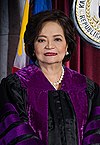
|
Teresita de Castro (born 1948) |
August 28, 2018 – October 10, 2018 (43 days) (Retired) |
Rodrigo Duterte | Associate Justice of the Supreme Court (2007–2018) | |
| 25 | 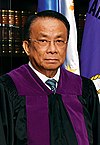
|
Lucas Bersamin (born 1949) |
November 26, 2018 – October 18, 2019 (326 days) (Retired) |
UE | Associate Justice of the Supreme Court (2009–2018) | |
| 26 | 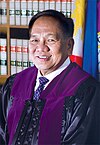
|
Diosdado Peralta (born 1952) |
October 23, 2019 – March 27, 2021 (1 year, 155 days) (Resigned) |
UST | Associate Justice of the Supreme Court (2009–2019) | |
| 27 | 
|
Alexander Gesmundo (born 1956) |
April 5, 2021 – present (3 years, 289 days) |
Ateneo | Associate Justice of the Supreme Court (2017–2021) |
- ^1 José Abad Santos was unable to preside over the Supreme Court due to the outbreak of World War II.
- ^2 Renato Corona was impeached on December 12, 2011, and convicted on May 29, 2012, removing him from office.
- ^3 Senior Associate Justice Antonio Carpio served as acting chief justice after the Impeachment of Renato Corona from May 30, 2012 to August 25, 2012 and after the removal of Maria Lourdes Sereno via quo warranto proceedings from May 14, 2018 to August 25, 2018.
- ^4 Maria Lourdes Sereno was removed on May 11, 2018 via quo warranto by a special en banc session; the petition alleged Sereno's appointment was void ab initio due to her failure in complying with the requirements of the Judicial and Bar Council. Hence her entire term as chief justice is considered a de facto tenure; legally void since the ouster of her predecessor. Sereno filed an ad cautelam motion for reconsideration pleading for the reversal of the decision on May 31, 2018, but on June 19, 2018 was denied with finality (meaning no further pleading shall be entertained, as well as for the immediate entry for judgment) for lack of merit.
- ^5 As a result of Republic v. Sereno, Maria Lourdes Sereno is no longer considered the 24th chief justice of the Philippines, as the court ruled that her appointment was never legal but null and void ab initio. Thus, on August 25, 2018, Teresita de Castro was appointed by President Rodrigo Duterte as the new de jure and 24th chief justice of the Supreme Court of the Philippines.
Acting Chief Justices
The following became Senior Associate Justices in their tenure in the Supreme Court:
| Senior Associate Justice | Year Appointed | Term as AJ | Tenure as Acting Chief Justice | |
|---|---|---|---|---|
| Florentino Torres | 1901 | 1901-1920 | April 1, 1920 | April 20, 1920 |
| Elias Finley Johnson | 1903 | 1903-1933 | April 20, 1920 | July 1, 1920 |
| October 31, 1921 | November 1, 1921 | |||
| July 26, 1924 | April 1, 1925 | |||
| José Abad Santos | 1932 | 1932-1941 | December 24, 1941 | |
| Manuel V. Moran | 1938 | 1938-1945 | May 1, 1942 | May 7, 1942 |
| Ricardo M. Paras Jr. | 1941 | 1941-1951 | March 20, 1951 | April 2, 1951 |
| César F. Bengzon | 1945 | 1945-1961 | February 17, 1961 | April 28, 1961 |
| Roberto R. Concepcion | 1954 | 1954-1966 | May 29, 1966 | June 17, 1966 |
| Querube C. Makalintal | 1962 | 1962-1973 | April 18, 1973 | October 21, 1973 |
| Fred Ruiz Castro | 1966 | 1966-1975 | December 22, 1975 | January 5, 1976 |
| Enrique M. Fernando Sr. | 1967 | 1967-1979 | April 19, 1979 | July 2, 1979 |
| Claudio Teehankee Sr. | 1968 | 1979-1986 | July 24, 1985 | July 25, 1985 |
| November 19, 1985 | November 20, 1985 | |||
| March 6, 1987 | April 1, 1987 | |||
| Ameurfina Melencio-Herrera | 1979
1986 (reappointed) |
1979-1992 | April 18, 1988 | April 19, 1988 |
| June 30, 1988 | July 1, 1988 | |||
| December 6, 1991 | December 8, 1991 | |||
| Flerida Ruth P. Romero | 1991 | 1991-1999 | November 30, 1998 | |
| Reynato S. Puno | 1993 | 1993 | December 20, 2005 | |
| Leonardo A. Quisumbing | 1998 | 1998-2009 | December 7, 2005 | |
| Antonio T. Carpio | 2001 | 2001-2019 | May 17, 2010 | |
| May 28, 2012 | August 25, 2012 | |||
| May 11, 2018 | August 28, 2018 | |||
| October 10, 2018 | November 28, 2018 | |||
| October 17, 2019 | October 23, 2019 | |||
| Estela M. Perlas-Bernabe | 2011 | 2011-2022 | March 27, 2022 | April 5, 2022 |
Demographics
Longevity
Ages of living chief justices as of 16:30, Sunday, January 19, 2025 (UTC)| Order | Chief justice |
Birth | Death | Age |
|---|---|---|---|---|
| 1 | César Bengzon | May 29, 1896 | September 3, 1992 | 96 years, 97 days |
| 2 | Ricardo Paras Jr. | February 17, 1891 | October 10, 1984 | 93 years, 236 days |
| 3 | Querube Makalintal | December 11, 1910 | November 8, 2002 | 91 years, 333 days |
| 4 | Enrique Fernando | July 25, 1915 | October 3, 2004 | 89 years, 70 days |
| 5 | Hilario Davide | December 20, 1935 | Living | 89 years, 30 days |
| 6 | Artemio Panganiban | December 7, 1937 | Living | 87 years, 43 days |
| 7 | Pedro Yap | July 1, 1918 | November 20, 2003 | 86 years, 142 days |
| 8 | Ramón Avanceña | April 13, 1872 | June 12, 1957 | 85 years, 60 days |
| 9 | Andres Narvasa | November 30, 1928 | October 31, 2013 | 84 years, 335 days |
| 10 | Reynato Puno | May 17, 1940 | Living | 84 years, 247 days |
| 11 | Roberto Concepcion | June 7, 1903 | May 3, 1987 | 83 years, 330 days |
| 12 | José Yulo | September 24, 1894 | October 27, 1976 | 82 years, 33 days |
| 13 | Felix Makasiar | August 31, 1917 | February 19, 1992 | 74 years, 172 days |
| 14 | Ramon Aquino | November 20, 1915 | March 31, 1993 | 77 years, 131 days |
| 15 | Teresita Leonardo-de Castro | October 8, 1948 | Living | 76 years, 103 days |
| 16 | Lucas Bersamin | October 18, 1949 | Living | 75 years, 93 days |
| 17 | Cayetano Arellano | March 2, 1847 | December 20, 1920 | 73 years, 293 days |
| 18 | Marcelo Fernán | October 24, 1926 | July 11, 1999 | 72 years, 260 days |
| 19 | Diosdado Peralta | March 27, 1952 | Living | 72 years, 298 days |
| 20 | Victorino Mapa | February 25, 1855 | April 12, 1927 | 72 years, 46 days |
| 21 | Manuel Araullo | January 1, 1853 | July 26, 1924 | 71 years, 207 days |
| 22 | Claudio Teehankee, Sr. | April 18, 1918 | July 11, 1989 | 71 years, 84 days |
| 23 | Manuel Moran | October 27, 1893 | August 23, 1961 | 67 years, 300 days |
| 24 | Alexander Gesmundo | November 6, 1956 | Living | 68 years, 74 days |
| 25 | Renato Corona | October 15, 1948 | April 29, 2016 | 67 years, 197 days |
| 26 | Fred Ruiz Castro | September 2, 1914 | April 19, 1979 | 64 years, 229 days |
| 27 | José Abad Santos | February 19, 1886 | May 2, 1942 | 56 years, 72 days |
By age group
| Age group | Total | % |
|---|---|---|
| Centenarians | 0 | 0% |
| Nonagenarians | 3 | 11% |
| Octogenarians | 8 | 29% |
| Septugenarians | 9 | 32% |
| Sexagenarian | 7 | 25% |
| Quincagenarian | 1 | 4% |
| Chief justices: | 28 |
By gender
| Gender | Total | % |
|---|---|---|
| Male | 26 | 93% |
| Female | 2 | 7% |
| Chief justices: | 28 | 100% |
By appointing president
| President | Total | % | |
|---|---|---|---|
| Ferdinand Marcos (KBL/Nacionalista) | 6 | 21% | |
| Corazon Aquino (UNIDO/Independent) | 4 | 14% | |
| Rodrigo Duterte (PDP–Laban) | 4 | 14% | |
| Gloria Macapagal Arroyo (Lakas) | 3 | 11% | |
| William McKinley (Republican) | 1 | 4% | |
| Woodrow Wilson (Democratic) | 1 | 4% | |
| Warren G. Harding (Republican) | 1 | 4% | |
| Calvin Coolidge (Republican) | 1 | 4% | |
| Manuel L. Quezon (Nacionalista) | 1 | 4% | |
| Sergio Osmeña (Nacionalista) | 1 | 4% | |
| Japanese Military Administration | 1 | 4% | |
| Elpidio Quirino (Liberal) | 1 | 4% | |
| Carlos P. Garcia (Nacionalista) | 1 | 4% | |
| Joseph Estrada (LAMMP) | 1 | 4% | |
| Benigno Aquino III (Liberal) | 1 | 4% | |
| Chief justices: | 28 | 100% | |
By law school
| Law school | Total | % |
|---|---|---|
| University of the Philippines College of Law | 14 | 50% |
| University of Santo Tomas Faculty of Civil Law | 7 | 25% |
| Ateneo School of Law | 3 | 11% |
| Escuela de Derecho | 1 | 4% |
| Far Eastern University Institute of Law | 1 | 4% |
| Northwestern University School of Law | 1 | 4% |
| University of the East College of Law | 1 | 4% |
| Chief justices: | 28 | 100% |
Notable chief justices
- José Yulo is the only former speaker of the House of Representatives to be subsequently appointed as chief justice. Another, Querube Makalintal, would be elected as Speaker of the Interim Batasang Pambansa (parliament) after his retirement from the court. On the other hand, Marcelo Fernan would, after his resignation from the court, be elected to the Senate and later serve as president of the Senate. Other chief justices served in prominent positions in public service after their retirement include Manuel Moran (ambassador to Spain and the Vatican), and Hilario Davide, Jr. (ambassador to the United Nations). In addition, César Bengzon was elected as the first Filipino to sit as a judge on the International Court of Justice shortly after his retirement in 1966.
- Roberto Concepcion was reputedly so disappointed with the court's ruling in Javellana v. Executive Secretary where the majority affirmed the validity of the 1973 Constitution despite recognizing the flaws in its ratification, that he retired two months prior to his reaching the mandatory retirement age of 70. Thirteen years later, after the ouster of Marcos, the 83-year-old Concepcion was appointed a member of the 1986 Constitutional Commission tasked with drafting a new constitution. Drawing from his experiences as chief justice in the early days of martial law, Concepcion introduced several new innovations designed to assure the independence of the Supreme Court, such as the Judicial and Bar Council and the express conferment on the court the power to review any acts of government.
- The longest period one person served as chief justice was 18 years, 294 days in the case of Cayetano Arellano, who served from 1901 to 1920. Arellano was 73 years, 29 days old upon his resignation, the greatest age ever reached by an incumbent chief justice, and a record unlikely to be broken with the current mandatory retirement age of 70.
- The shortest tenure of any chief justice was of Teresita Leonardo-de Castro, who served as chief justice for a mere 43 days upon reaching her mandatory retirement age of 70. The previous record was that of Pedro Yap, who served as chief justice for 73 days in 1988. Other chief justices who served for less than a year were Felix Makasiar (85 days), Ramon Aquino (78 days), and Artemio Panganiban (352 days). Of these chief justices, all but Aquino left office upon reaching the mandatory retirement age of 70; Aquino resigned in 1986 after the newly installed President Corazon Aquino asked for the courtesy resignations of all the members of the court.
- The oldest person appointed as chief justice was Teresita Leonardo-de Castro, who was 69 years, 324 days old upon his appointment in 2018. Other persons appointed as chief justice in their 69th year were Pedro Yap (69 years, 292 days old); Felix Makasiar (69 years, 280 days old); Artemio Panganiban (69 years, 13 days old); and Lucas Bersamin (69 years, 41 days). The youngest person named as chief justice was Manuel Moran, who was 51 years, 256 days old upon his appointment.
- Claudio Teehankee had to wait for nearly 18 years as associate justice before he was appointed as chief justice. He was twice bypassed by Ferdinand Marcos in favor a more junior associate justice before he was finally appointed chief justice by Corazon Aquino. Of the Filipino associate justices, Florentino Torres and J. B. L. Reyes served over 18 years in the court without becoming chief justice. In contrast, Pedro Yap had served as associate justice for only 2 years, 10 days before he was promoted as chief justice.
- The longest-lived chief justice was César Bengzon, who died in 1992 aged 96 years, 97 days old. Two other chief justices lived past 90: Ricardo Paras (93 years, 235 days) and Querube Makalintal (91 years, 322 days).
- The youngest chief justice to die was José Abad Santos, who was executed by the Japanese army in 1942 at age 56 years, 77 days. The youngest chief justice to die from non-violent causes was Fred Ruiz Castro, who died in 1979 of a heart attack inflight to India, at age 64 years, 231 days. Abad Santos, Castro, and Manuel Araullo are the only chief justices to die while in office.
- The first chief justice to be impeached is Renato Corona. On December 12, 2011, 188 of the 285 members of House of Representatives voted to transmit to the Senate the Articles of Impeachment filed against him. On May 29, 2012, the Senate, voting 20–3, convicted Corona under Article II pertaining to his failure to disclose to the public his statement of assets, liabilities, and net worth.
- Maria Lourdes Sereno was the first female appointed to serve as chief justice, following the impeachment of Renato Corona and deliberations by the Judicial and Bar Council in 2012 (her successor Teresita Leonardo-de Castro is the de jure first female chief justice). If not for the quo warranto petition which was granted on May 11, 2018, that removed her from the post as well as voiding her appointment and declaring her tenure as a de facto term, she would have been the second chief justice to similarly undergo impeachment proceedings as her late predecessor, Corona. Her ouster was made final on June 19, 2018, by the denial with finality (meaning no further pleading would be entertained, as well as for the immediate entry for judgment) of her ad cautelam motion for reconsideration filed on May 31, 2018, pleading for the reversal of her ouster via quo warranto.
Timeline

Gallery
-
Portraits of the chief justices at the Supreme Court Building
-
The chief justice's judicial chambers
-
Reception room for the Office of the Chief Justice
See also
- Associate Justice of the Supreme Court of the Philippines
- Supreme Court of the Philippines
- Constitution of the Philippines
- Justices of the Supreme Court of the Philippines
References
- "Carpio is acting chief justice under SC order". Philippine Daily Inquirer. May 30, 2012. Retrieved May 30, 2012.
- ^ "G.R. No. 237428. May 11, 2018" (PDF). Supreme Court of the Philippines. May 11, 2018. Archived from the original (PDF) on June 20, 2018. Retrieved May 11, 2018.
- ^ "G.R. No. 237428. June 19, 2018" (PDF). Supreme Court of the Philippines. June 19, 2018. Archived from the original (PDF) on June 20, 2018. Retrieved June 20, 2018.
- Updated daily according to UTC.
- "Senate votes 20-3 to convict Corona". Inquirer.net. May 29, 2012. Retrieved May 30, 2012.
Further reading
- The Supreme Court E-library
- The Chief Justice on the Official Gazette of the Philippines
- Sevilla, Victor J. (1985). Justices of the Supreme Court of the Philippines Vol. I. Quezon City, Philippines: New Day Publishers. ISBN 971-10-0134-9.
- Sevilla, Victor J. (1985). Justices of the Supreme Court of the Philippines Vol. II. Quezon City, Philippines: New Day Publishers. ISBN 971-10-0137-3.
- Sevilla, Victor J. (1985). Justices of the Supreme Court of the Philippines Vol. III. Quezon City, Philippines: New Day Publishers. ISBN 971-10-0139-X.
| The Gesmundo Court | ||
|---|---|---|
| 2021–present (current composition, starting April 5, 2021, following the appointment of Alexander Gesmundo as CJ) |

